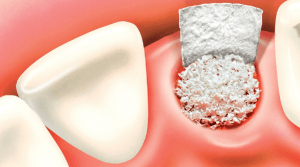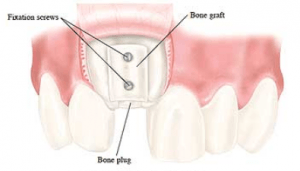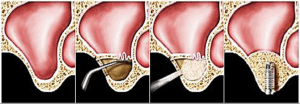
The biggest challenge to placing dental implants is finding enough bone to support the implant post
Bone Grafting
Bone grafting is commonly performed in conjunction with dental implant treatment. The function of a bone graft is to fill in the voids to promote bone growth. This improves the chances of the implant post locking in place. Bone graft is commonly placed after removing teeth to preserve the socket for future implant placement. Bone graft is also commonly used at the time of implant placement to promote additional bone growth surrounding the implant post. Bone graft material is obtained from various sources. It can be synthetic, cadaver (allograft), pig (xenograft), cow (bovine), or even come from another part of your own body (autogenous bone graft).
Block Bone Graft
While most bone grafting procedures are straightforward, there are certain grafting procedures that are very complex. One example of this is a block bone graft. Block bone grafting is a complex procedure that is used to replace large bony defects, where a simple graft is incapable of restoring the missing bone. This procedure restores bone height that allows your dentist to place implants in areas that don't have sufficient jawbone. Block graft is obtained from a donor site, typically from your own body. This could be from the chin, the ramus of mandible, or even your rib cage for more extensive bony defects. Block grafts are fixed in place with fixation screws to stabilize the graft material and allow it to heal properly. Often times, your dentist or surgeon will draw blood, a process known as Platelet Rich Fibrin (PRF), to improve soft tissue and bone regeneration surrounding the block graft. Once healed, your dentist will remove the screw and your jawbone should be sufficient to receive its implants. Keep in mind, this is a long, painful, and expensive treatment that may take one to two to complete.

Block bone grafting procedure requires fixation screws to stabilize the graft in its place
Sinus Lift
A sinus lift is used to place dental implants in the upper posterior jaw area when there insufficient jawbone. For those of you who are dental savvy, there are teeth #2, 3, 4, 13, 14, and 15, and occasionally teeth #5 and 12 as well. You require a sinus lift whenever there's not enough bone under the sinus membrane to place a dental implant post. Your dentist will elevate the sinus membrane, pack some bone, and place a large enough dental implant. Once healed, you can use this implant to restore your missing tooth or teeth.
Lateral Wall Sinus Graft
A lateral wall sinus graft is a sinus augmentation reserved for the most extreme cases. You can use a sinus lift whenever you have about 4 mm to 8 mm of remaining jawbone under the sinus membrane. However, when there is only 2 mm to 3 mm of bone under the sinus, a simple lift will not work. Instead, you require a lateral wall sinus graft to restore the missing jawbone. To perform a lateral wall sinus graft, your dentist cuts a hole to access the sinus membrane. Next, your dentist manually pushes the sinus membrane up. This allows your dentist to add a significant amount of bone underneath the sinuses. Once healed, there will be more than enough room to place multiple implant posts underneath the sinus. This is a very complex, expensive, and difficult surgery. It takes at least one week to recover from a lateral wall sinus graft procedure. Be sure to get lots of rest. Avoid putting any unwanted pressure on your sinuses. No blowing your nose, no straws, and no coughing or sneezing (if you must, then do it with your mouth open) until you've recovered from your urgery.

A lateral wall sinus graft is indicated when there is hardly any jawbone under the sinus.membrane
How much do these treatments cost?
The cost of the surgeries depends on the complexity of the treatment. Unfortunately, this cost is always in addition to the cost of the implant treatment itself. To start, a standard bone grafting procedure is the least expensive procedure. Most bone graft treatments cost a few hundred dollars, maybe up to a thousand dollars or so. Next is the sinus lift procedure. This procedure is a bit more tricky so the cost is likely to get closer to a thousand dollars or a bit more. Finally, there are the block bone grafts and lateral wall sinus graft procedures. These surgeries are very complex and therefore quite expensive. These surgeries require lots of costly raw materials such as processed grafts, screws, membranes, etc. which makes them even more expensive. A block graft or lateral wall sinus graft typically costs several thousands of dollars, which is in addition to the cost of the actual implant posts. These surgeries are not inexpensive. However, there really is no better investment in your oral health, beauty, and confidence than getting your teeth back with dental implants!
0 Comments